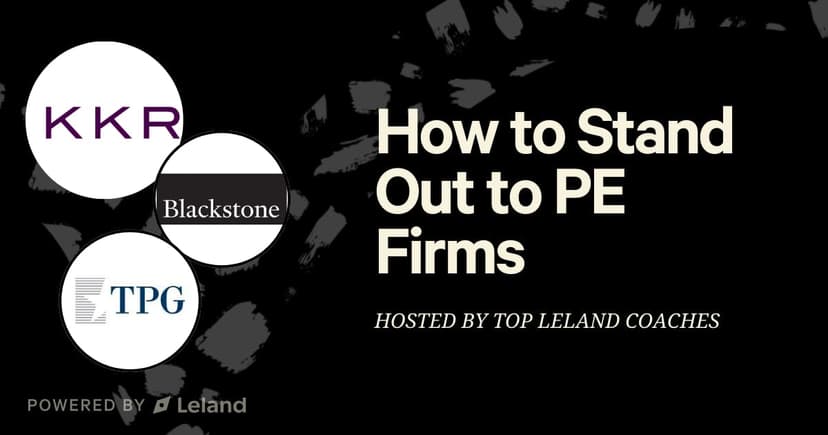How Does Private Equity Work? A Complete Beginner’s Guide to the PE Industry
Curious how private equity works? This beginner-friendly guide explains how PE firms raise funds, buy companies, create value, and deliver returns step-by-step. Perfect for students, job seekers, and curious investors.
Posted July 30, 2025

Join a free event
Learn from top coaches and industry experts in live, interactive sessions you can join for free.
Table of Contents
Private equity can seem complex, but at its core, it’s a straightforward idea: buy companies, improve them, and sell them for a profit. In this article, I’ll break down how private equity works, who’s involved, and how firms raise capital, invest, and create value. Whether you're a student, job seeker, or someone curious about alternative investments, this guide will help you understand the private equity industry from the ground up.
What Is Private Equity?
Private equity refers to investments in private companies, businesses that are not listed on a public stock exchange. Private equity firms raise capital from institutional and accredited investors and use that money to buy companies, improve their performance, and later sell them at a higher value.
Private equity is a type of equity investment made outside of the public markets. It’s different from venture capital, which typically focuses on startups, and hedge funds, which often trade public securities. Private equity firms focus on mature companies with steady cash flow and room for operational or strategic improvements.
Who Are the Key Players in Private Equity?
Understanding how private equity works requires knowing who drives the decisions, who supplies the capital, and who the capital is used to acquire. The three core groups in any private equity fund structure are the General Partners (GPs), Limited Partners (LPs), and portfolio companies. Each plays a distinct role in the value creation and return generation process.
General Partners (GPs): The Decision-Makers and Fund Managers
General Partners are the private equity firms responsible for raising capital, executing deals, managing portfolio companies, and delivering investment returns. They control every aspect of the fund’s life, from sourcing deals and conducting due diligence to driving operational improvements and negotiating exits. GPs contribute a small percentage of the fund’s capital (typically 1–3%) to align their interests with those of their investors. They are compensated in two main ways:
- Management Fee: Usually 2% of committed capital annually, paid regardless of fund performance.
- Carried Interest: Typically 20% of profits above a preferred return (often 8%), acting as a performance-based incentive.
Typical PE Firm Hierarchy:
| Title | Role & Responsibilities |
|---|---|
| Analyst | Conducts financial modeling, market research, and prepares internal memos. Entry-level role for top-performing undergrads or post-IB analysts. |
| Associate / Senior Associate | Supports deal sourcing and due diligence. Interacts with portfolio company teams. Typically post-IB or MBA hire. |
| Vice President (VP) | Leads the execution of transactions. Oversees analysts and associates. Builds relationships with bankers and targets. |
| Principal / Director | Drives sourcing, manages full deal lifecycle. Works closely with LPs and the investment committee. |
| Partner / Managing Director | Sets fund strategy. Has final decision-making power. Manages key LP relationships. Often leads major deals and exits. |
Note: In top-performing firms, roles are tightly defined and advancement is based on deal performance, sourcing ability, and leadership.
Limited Partners (LPs): The Capital Providers
Limited Partners supply the majority of the capital in a private equity fund. LPs do not manage the fund but instead commit capital for the entire duration of the fund’s life (usually 10–12 years). Their role is passive, but they can participate in advisory committees (LPACs) that provide feedback and approve certain decisions, like conflicts of interest or fund extensions.
Common Types of LPs:
- Pension funds: Allocate capital to PE to meet long-term return targets for retirees.
- Insurance firms: Seek illiquid assets with long-term yield potential.
- Endowments and Foundations: Use PE as part of a diversified alternative asset strategy.
- Sovereign Wealth Funds: Deploy capital globally to reduce dependency on commodity cycles.
- Fund-of-funds: Intermediaries that invest on behalf of smaller institutions or family offices.
- High Net Worth Individuals and Family Offices: Often invest through feeder funds or co-investments.
Characteristics of LPs:
| Feature | Description |
|---|---|
| Capital Commitment | Typically made upfront but called over 4–5 years during the investment period. |
| Return Expectation | Target net IRR of 15–20%, depending on strategy and risk level. |
| Risk | Exposure is limited to committed capital. No direct legal or operational liability. |
Note: Many LPs allocate capital across multiple private equity funds and strategies to spread risk.
Portfolio Companies: The Core Assets Being Transformed
Portfolio companies are the businesses that a private equity fund acquires. These can be:
- Private companies seeking growth capital or succession planning.
- Public companies acquired in take-private transactions.
- Business units carved out of larger corporations (often underperforming or non-core).
Expert Tip: Once acquired, the PE firm often takes a majority ownership stake and assumes board control. In other cases, especially in growth equity deals, the firm may take a minority share while gaining governance rights and financial oversight.
What Happens After Acquisition:
- Operational improvements: Reducing costs, boosting efficiency, expanding into new markets.
- Financial engineering: Optimizing capital structure and tax efficiency.
- Leadership upgrades: Recruiting new executives or incentivizing current teams.
- KPI tracking: Regular performance reviews using dashboards tied to cash flow, EBITDA, and strategic milestones.
Note: PE firms tend to hold companies for 4 to 7 years, after which they aim to exit via a strategic sale, IPO, or secondary buyout.
Summary of Roles
| Player | Role in the PE Ecosystem |
|---|---|
| GPs | Select investments, manage portfolio companies, and drive returns. |
| LPs | Provide capital and monitor performance. Have no role in operations. |
| Portfolio Companies | The actual businesses are being improved and later sold. Generate the fund’s returns. |
How Private Equity Firms Raise Money
Raising capital is the first and most important step for private equity firms. Before they can invest in private companies or execute any strategy, PE firms must raise a fund from external investors. This process, known as fundraising, involves marketing a clear investment thesis, showing a strong track record, and securing commitments from institutional and accredited investors. A typical fund is structured as a Limited Partnership, where the General Partner (GP) manages the fund and the Limited Partners (LPs) provide the bulk of the capital.
The Private Equity Fund Lifecycle
| Phase | Years | Purpose |
|---|---|---|
| Investment Period | Years 1–5 | The GP identifies, evaluates, and acquires portfolio companies. LPs commit capital, but it is only drawn down (called) as needed. |
| Harvesting Period | Years 6–10 | The GP focuses on managing and exiting investments. This is when the value creation work pays off through sales, IPOs, or secondary buyouts. |
Key Elements of Fund Structure
| Term | Description |
|---|---|
| Fund Life | Typically 10 years with optional extensions |
| Legal Structure | Limited Partnership: LPs provide capital, GP manages operations |
| Capital Calls | LPs commit a total amount up front, but capital is drawn as needed (via scheduled capital calls) |
| Fund Size | Ranges from $100 million (middle market) to $10 billion+ (mega funds) |
Note: Funds are usually blind pools, meaning LPs commit capital before knowing the specific deals the GP will pursue. This makes track record, team experience, and strategy clarity critical to a successful raise.
Who Invests in PE Funds?
The LP base for most private equity funds includes:
- Pension funds
- Insurance firms
- University endowments
- Sovereign wealth funds
- Fund-of-funds
- Family offices
- High net worth individuals (via feeder funds or private bank channels)
Fundraising Strategy: What PE Firms Pitch
- Strategy type (e.g., buyout, growth equity, distressed assets)
- Target companies (sector, geography, size)
- Value creation model (operational improvements, market expansion, M&A rollups)
- Track record (realized vs unrealized returns, IRRs, MOICs)
- Team bios and roles (analysts, senior associates, partners)
- Terms and fees (typically a 2% management fee and 20% carried interest)
Note: Fundraising can take 6–18 months, depending on fund size, market conditions, and the firm’s history. Top-quartile firms often secure commitments more quickly and are oversubscribed.
Types of Strategies PE Firms Raise Capital For
| Strategy | Description |
|---|---|
| Buyouts | Control investments in mature companies using leverage to enhance returns |
| Growth Equity | Minority investments in established companies with expansion potential |
| Distressed | Buying underperforming businesses or debt with plans to restructure |
| Venture Capital | Investing in early-stage private companies (usually done by VC firms or hybrid platforms) |
| Real Assets / Infrastructure | Capital-intensive investments in physical assets (energy, utilities, etc.) with predictable cash flow |
How Does the Private Equity Investment Process Work?
Sourcing Deals
Private equity firms find investment opportunities through a mix of formal and informal channels. Investment banks are a major source, often running competitive auctions where firms bid against each other. In these cases, speed and pricing are critical. However, many firms prefer proprietary sourcing, identifying and approaching companies directly, which can reduce competition and improve terms. This approach depends heavily on building long-term relationships with business owners, executives, and advisors across industries. Some deals also come through trusted referrals, especially from law firms, consultants, and other private equity professionals. The best firms maintain consistent deal flow by combining institutional relationships with strong internal sourcing teams.
Due Diligence
Before committing to an acquisition, firms conduct due diligence to verify the quality of the business. This includes a full review of the company’s financial statements, historical performance, and projections. Firms assess whether the business has sustainable margins, strong cash flow, and growth potential. Operational diligence focuses on processes, systems, supply chains, and other internal factors that may affect future performance. Legal and compliance reviews help uncover liabilities that may impact the deal or its structure. Evaluating the management team is also a priority; firms look for capability, alignment, and a willingness to operate under new ownership. At the end of this process, the deal team presents its findings to the investment committee, which makes the final decision on whether to move forward.
Deal Structuring
If the investment is approved, the next step is to finalize the terms. Most private equity deals are structured using both debt and equity. In a leveraged buyout (LBO), the firm contributes a portion of the capital and borrows the rest, often using the target company’s assets and cash flow as collateral. The goal is to increase returns by putting less equity at risk while ensuring that the debt can be repaid through operating cash flow. In growth equity transactions, firms may use less leverage and take a minority position, depending on the needs of the business. Deal structuring also involves negotiating management incentives, governance rights, and the timing of capital deployment. A strong structure creates alignment across investors, leadership, and lenders from the beginning.
Closing and Ownership
Once the deal is closed, the firm takes ownership of the business and begins executing the value creation plan. This phase often starts with a review of the leadership team. In some cases, the existing CEO stays on with new financial incentives tied to performance. In others, the firm may bring in new executives with a track record of executing on similar plans. Governance changes are common, board seats are filled by partners or advisors, and reporting expectations are established. The firm typically works closely with management during the first 90 days to review priorities, refine the strategy, and implement operational improvements. From that point on, the goal is to grow revenue, expand margins, and prepare the company for a profitable exit.
How PE Firms Create Value
After acquiring a company, private equity firms focus on increasing its value through a set of proven strategies. These strategies fall into four main categories: operational improvements, strategic growth, financial engineering, and management incentives. Each one is aimed at improving performance, expanding margins, and positioning the business for a profitable exit.
Operational Improvements
Private equity firms often start with fixing inefficiencies in how the company runs day to day. This includes reducing overhead, simplifying workflows, and standardizing systems across locations or departments. Common tactics involve cutting unnecessary expenses, renegotiating supplier contracts, and centralizing back-office functions such as IT, finance, and HR.
Firms also introduce new tools for tracking KPIs and performance in real time. Updated accounting systems, inventory controls, and demand forecasting models help improve decisions and tighten control over cash flow. These changes usually take effect within the first 6–12 months of ownership and set the foundation for longer-term growth.
Strategic Growth
Beyond cost savings, PE firms look for ways to grow revenue. They help companies expand into new geographic markets, roll out new products, or launch new business units. Some firms use a “platform and add-on” model, where a larger business acquires smaller, related companies to expand market share or enter adjacent sectors.
Strategic growth may also involve building new sales channels, such as B2B distribution, partnerships, or online commerce, that didn’t exist under the previous ownership. The goal is to accelerate top-line growth in a way that creates long-term value without overextending the business.
Financial Engineering
Private equity firms frequently restructure a company’s balance sheet to improve financial efficiency. This could involve refinancing existing debt at more favorable terms or adjusting capital allocation between growth projects, interest payments, and working capital.
In many deals, the firm also simplifies the corporate structure to take advantage of tax benefits or to create flexibility for future exits. While financial engineering doesn’t improve the product or service directly, it plays a critical role in increasing the company's equity value and return on invested capital.
Management Incentives
Alignment with leadership is a central part of most private equity strategies. Firms typically restructure executive compensation to include equity ownership or options that vest based on specific milestones, like hitting EBITDA targets or achieving a certain exit valuation.
This shift turns management into stakeholders. When they grow the business, they directly benefit at the exit. Equity ownership helps retain key talent, strengthens accountability, and focuses the team on measurable outcomes.
How Do PE Firms Exit Investments?
Private equity firms typically aim to exit investments within 4 to 7 years, once the portfolio company has grown in value. The goal is to generate strong returns and distribute profits back to limited partners.
Common Exit Strategies
- Initial Public Offering (IPO): Selling shares on the public market to unlock value and gain liquidity.
- Strategic Sale: Selling the company to a corporate buyer looking for synergies or market expansion.
- Secondary Buyout: Selling the company to another private equity firm for further growth or consolidation.
How Returns Are Measured
- IRR (Internal Rate of Return): Annualized performance based on time held.
- MOIC (Multiple on Invested Capital): Total return compared to the original equity investment.
How Do Private Equity Firms Make Money?
Private equity firms earn money through two main sources: management fees and carried interest. These payments reward the firm for managing investor capital and delivering strong returns.
Revenue Streams for General Partners (GPs)
| Revenue Type | Description |
|---|---|
| Management Fee | A fixed fee, typically 2% of committed capital per year, paid by LPs to cover operating costs. |
| Carried Interest | A share of profits, usually 20%, is earned if the fund exceeds a set return, often 8% (the hurdle rate). |
Example
If a PE firm raises a $1 billion fund:
- It earns $20 million per year in management fees.
- If it returns $2 billion to investors, the firm keeps $200 million (20% of the $1 billion gain) as carried interest.
Common Private Equity Strategies
Leveraged Buyouts (LBOs)
LBOs involve acquiring a company using a significant amount of debt, often financing 50–70% of the purchase price. The goal is to improve operations and use the company’s cash flow to repay the debt. LBOs are the most common strategy across the private equity industry, especially for control investments in mature companies.
Growth Equity
This strategy focuses on minority investments in established companies that are profitable but need capital to expand. PE firms provide funding to accelerate growth without taking full control. Growth equity is often used in software, healthcare, and consumer businesses that are past the startup phase but not ready for a sale or IPO.
Venture Capital
Venture capital targets early-stage businesses with high growth potential. While VC firms typically specialize in this area, some private equity funds include venture arms or separate vehicles. These deals carry higher risk and longer hold times but can offer large returns if successful.
Distressed Investing
This strategy involves buying underperforming or financially troubled companies at a discount. The firm restructures its business operationally or financially to recover value. It’s often used during market downturns or in cyclical industries.
Real Assets & Infrastructure
These are long-term investments in physical assets like utilities, toll roads, or energy projects. They typically offer stable cash flow, inflation protection, and lower volatility, making them appealing to certain institutional investors.
Pros and Cons of Private Equity
| Pros | Cons |
|---|---|
| High return potential: PE aims for outsized gains through operational improvements and strategic exits. | Illiquidity: Capital is locked up for 8–12 years with limited early access. |
| Direct influence over business strategy: Firms often gain board control and shape key decisions. | High financial risk: Heavy use of debt (LBOs) can increase the chance of failure if cash flow declines. |
| Long-term focus: PE firms hold companies long enough to drive real change and value. | Limited transparency: Investors have less visibility into performance, fees, and holdings than with public funds. |
| Strong alignment with management: Executives receive equity or bonuses tied to performance, improving execution. | Complex fee structures: Standard “2 and 20” model reduces net returns if the fund underperforms. |
| Access to private markets: PE offers exposure to private companies not available through public equity or mutual funds. | Delayed performance feedback: Results often take years, making it harder to evaluate fund success early on. |
How to Start a Career in Private Equity
What Firms Look For
Most PE firms hire candidates with backgrounds in investment banking, management consulting, or Big Four accounting. These roles provide experience in deal execution, financial modeling, and business analysis, core skills in private equity. Strong technical ability, sound judgment, and understanding of private equity strategies are key.
Entry-Level Roles
Common entry points include:
- Analyst (pre-MBA): Typically hired from top investment banks.
- Associate (post-IB or post-MBA): Responsible for modeling, due diligence, and portfolio monitoring.
Recruiting is often closed-loop and relationship-driven, with many roles filled through referrals or on-campus programs at target schools. Learning how private equity works, fund structure, value creation, and exits, early on helps candidates build relevant experience, network effectively, and prepare for technical interviews.
Want to Break Into Private Equity? Start by Understanding How It Works
Breaking into private equity can be challenging, but thorough preparation makes a significant difference. Top firms manage trillions in assets and recruit from a narrow pool of candidates with strong technical and commercial skills. If you're serious about landing a role, start by mastering how private equity firms operate: how funds are raised, how deals are sourced and structured, and how value is created over a fund’s life.
Develop fluency in key concepts such as leveraged buyouts, growth equity, and carried interest. Know the structure of a private equity team and understand what the investment committee looks for in a deal. Technical skills, particularly financial modeling, deal analysis, and valuation, are non-negotiable. Commercial thinking, attention to detail, and familiarity with industry-specific metrics will distinguish you.
The earlier you understand how private equity works, the better you can position your resume, networking efforts, and interview prep. Whether you're coming from investment banking, consulting, or a target academic program, knowing the fundamentals gives you an edge.
Work With a Private Equity Coach Today
If you’re aiming for a role in private equity, working with someone who understands the recruiting cycle, technical expectations, and deal-making process can give you a real advantage. Leland connects you with top private equity coaches who’ve worked at leading firms and helped candidates succeed in analyst and associate recruiting. Whether you're preparing for interviews, building your technical skills, or making the switch from banking or consulting, personalized coaching can help you stand out.
Here are a few ways to get started:
- Read verified reviews from students and professionals who’ve landed PE offers with coach support
- Join free private equity and recruiting events to learn about timelines, strategies, and firm expectations
- Explore our PE Bootcamp for hands-on help with modeling, case prep, and recruiting timelines
Read these next:
- A Guide to Private Equity Valuation: How It Works
- Top Skills You Need to Break Into Private Equity
- Private Equity Roles: The Different Career Paths
- Private Equity Analyst: Role, Responsibilities, & Salary
- Private Equity Interviews: The Ultimate Guide
How Does Private Equity Work? – FAQs
How does private equity really work?
- Private equity firms raise money from investors, buy private companies, improve their operations or financials, and later sell them for a profit.
How do private equity people make money?
- They earn an annual management fee (typically 2%) and a cut of the profits above a certain return threshold, which is called carried interest.
What is the 2:20 rule in private equity?
- It refers to the standard fee structure: 2% of committed capital as a management fee and 20% of profits over an 8% hurdle rate.
How does private equity work for dummies?
- A PE firm buys a company, tries to make it more profitable or efficient, and then sells it for more than they paid.
What is a leveraged buyout (LBO)?
- An LBO is when a PE firm uses debt to finance most of a company’s purchase price, with the acquired company’s cash flow used to repay the loan.
Browse hundreds of expert coaches
Leland coaches have helped thousands of people achieve their goals. A dedicated mentor can make all the difference.


















